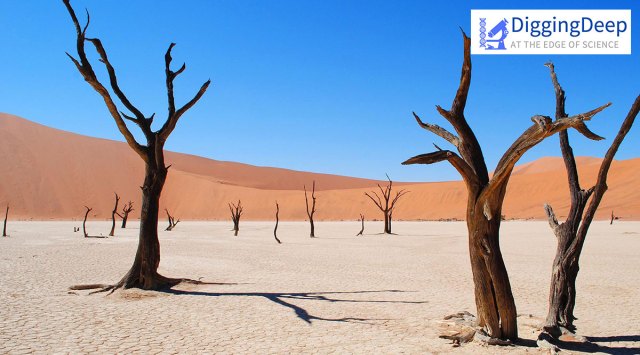- India
- International
Digging Deep: The deserts of the world are spreading further North
The study showed that over the course of the last two-three decades, the precipitation and temperature profiles characteristic of a desert biome have spread further east and north.
 The deserts of the world have been inching Northwards since the 1980s and have actually moved more than just the proverbial inch, according to a new study. (Image credit: Pixabay)
The deserts of the world have been inching Northwards since the 1980s and have actually moved more than just the proverbial inch, according to a new study. (Image credit: Pixabay) A recent study shows that the deserts of the world have been inching Northwards since the 1980s and have actually moved more than just the proverbial inch. Writing in Geophysical Research Letters, Hu and Han (2022) report that, in geographical regions such as Central Asia, desert biomes have moved by an order of hundreds of kilometres. The region is particularly vulnerable to even the minutest of deviations in temperature and precipitation. A 2016 risk assessment conducted by World Bank highlighted how weather impacts can force the region’s economy – especially agriculture – into a vicious ‘shock-recovery-shock’ cycle exacerbating poverty traps and ‘compromising long-term growth.’
The study modelled these climatic shifts by tapping into air temperature and precipitation data for Central Asia since 1960 that is covering a span of over sixty years. They then divided the area into eleven different climate types. These eleven climate types are largely sourced from the climate classifications established by the German-Russian climatologist Wladimir Koeppen in the 1930s, and then further developed by the American geographer Glenn Thomas Trewartha in the 1970s/80s.
The study’s data was sourced from the European Centre for Medium-Range Weather Forecasts (ECMWF) and its Copernicus Climate Change Service (C3S) and was supplemented by Climatic Research Unit gridded Time Series that provides climate data at a very high resolution.
It was found that over the course of the last two-three decades, the precipitation and temperature profiles characteristic of a desert biome have spread further east and north. Actual measurements are quite telling in themselves. Some areas, for the 1990-2020 period, recorded average annual temperatures 5 °C higher than those recorded for the 1960-79 period.
The expansion encompasses areas in northern Uzbekistan and Kyrgyzstan, in southern Kazakhstan and around the Junggar Basin in north-western China. It is a cascade effect, the study predicts. Many of the adjoining areas have also become drier as the region has witnessed an overall increase in temperature, thereby accelerating the process of deglaciation.

The analysis revealed that not only have temperate boreal steppes turned to temperate cold deserts, with rainfall confined to winter months and aridity becoming pronounced in summer; it also showed that temperate boreal steppe has expanded as well into broadleaf deciduous forests to the North and East. At the same time, in the higher latitudes up north, particularly Kazakhstan, the needleleaf evergreen/deciduous forests have expanded both North and South, making the area wetter.
These contemporaneous changes have made the temperature gradient between the mid- and the high-latitudes quite steep – like an envelope of cold/wet climate around a dry desert/steppe-like biome. This has considerable implications with respect to the atmosphere as well, preventing cloud formation and, thereby, creating an even drier climate.
A key concern here is how the local ecosystems will respond to the disruption. As temperatures rise, it quickens the rate of moisture loss from soil through evaporation and makes a drought-like situation imminent. When the plant community structure changes – with plants adapted to hotter conditions slowly dominating the landscape – it will change the faunal community structure as well.
Neither is the response of all biomes to changes in temperature and precipitation uniform. In the mountain ranges of NW China, for instance, temperature increase has resulted in an increase in the proportion of precipitation that takes place as rainfall, as opposed to snowfall. The phenomenon is augmenting glacial retreat at an unprecedented pace, the study says. This has massive repercussions for habitats downstream, with reduced amounts of meltwater reaching lowlands that harbour agricultural settlements.
“[In] future, when glaciers have retreated and snowpacks are pretty much diminished; [the] warmer climate in high altitudes would allow more precipitation falling in liquid form. That could reduce snow accumulation in winter months, leaving little snowpack to generate meltwater and support streams and groundwater in the warm season,” Professor Steve Hu of the University of Nebraska-Lincoln, the first author of the paper, clarified in an email to indianexpress.com.
These rapid perturbations and oscillations between flood and drought conditions, and an ultimate lack of available irrigable water, will veritably make agriculture extremely vulnerable. Currently, however, the rapid pace of glacier retreat is feeding rises in groundwater and bodies of surface water, including lakes, across western China’s Xinjiang Province and similarly mountainous areas. “But this is likely at the expense of more sustainable meltwater,” Professor Hu emphasised in a press release.
The author is a research fellow at the Indian Institute of Science (IISc), Bengaluru, and a freelance science communicator. He tweets at @critvik
Apr 26: Latest News
- 01
- 02
- 03
- 04
- 05








































